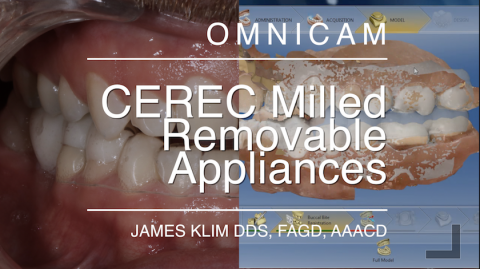My favored posterior design proposing method is Biogeneric Individual. When in the clinical flow of treating teeth in the upper buccal posterior corridors, I routinely take a BioCopy preliminary catalog scan even when using Biogeneric Individual. During the design phase, activating the BioCopy and using it as a translucent overlay will provide design assistance for the buccal corridor contour and still gain the benefit for superb occlusal morphology that Biogeneric Individual will provide.
Submitted by James Klim DDS, CADStar host on 07/26/2018 - 9:38pm
Submitted by James Klim DDS, CADStar host on 07/22/2018 - 9:02pm
This Klim Digital Moment video is more about my gratitude for the Omnicam. This week I had several posterior molars that were difficult to access with subgingival decay resulting in a deep margin situation. With bur curettage and Hemostatic Gel for hemorrhage control, imaging these deep margins were seamless. Situations like this with an analog impress are almost impossible to accomplish. I am so thankful for Omnicam.
View Video Preview
View Full Video
Submitted by James Klim DDS, CADStar host on 07/15/2018 - 1:23pm
We all get this situation in our career, second molar crown, and minimal room. This case review documents a solution for difficult access teeth with minimal occlusal room and needs a high stress enduring crown. With CEREC and a broad range of materials, we now have the support for the majority of functional and aesthetic clinical demands that enter our clinical theaters.
Materials used:
- ZirCAD LT (Ivoclar Vivadent)
- Sirona Zirconia (Densply Sirona)
- MCXL Dry Mill (Dentsply Sirona)
- SpeedFire Furnance (Dentsply Sirona)
- CS4 Furnance (Ivoclar Vivadent)
- S1 Furnance (Ivoclar
Submitted by James Klim DDS, CADStar host on 07/08/2018 - 10:36am
This tutorial will demonstrate my step-by-step glaze and stain technique customizing the solid e.max abutment/crown. My current favored stain and glaze system is Ivocolor. It is a universal stain and glaze system "one on all" and works well on micro felspathic, lucite, disilicate, and zirconia surfaces. Ivocolor is a very forgiving system, basically no bubbling. It is very predictable, what you see with stain color harmony in the application state will be what is seen in the post-firing condition.
Product Recommendations:
- Object Fix Flowable (Ivoclar Vivadent)
Submitted by James Klim DDS, CADStar host on 07/02/2018 - 9:18pm
Solid abutment/crown shaping is not much different than shaping an e.max traditional restoration. This tutorial will demonstrate Dr. Klim's shaping and polishing sequence using his Meisinger Lab Kit JK03.
Support Products:
- Meisinger JK03 Lab Kit
- e.max 16 implant block
- Diamond Twist (Premier)
- Object Fix--flowable (Ivoclar/Vivadent)
View Video Preview
View Full Video for Members
Submitted by James Klim DDS, CADStar host on 06/28/2018 - 6:35am
The CEREC software is at a point in time when creativity has new horizons. This video will introduce how I use the software and PMMA Telio CAD blocks to make a splint appliance for TMD clients and part of the preliminary process when increasing the vertical for restorative purposes.
View Preview Video
View Full Video for Members
Submitted by James Klim DDS, CADStar host on 06/14/2018 - 5:18pm
Finishing zirconia when it comes out of the milling unit is referred to as zirconia in the green state. There are a few steps that can be taken to really improve the surface quality of the green zirconia, and once sintered will save finishing time.
View Video Preview
View Video for Members
Submitted by James Klim DDS, CADStar host on 06/10/2018 - 5:37pm
Omnicam interproximal and posterior distal axial surfaces are often difficult to capture when there is a limited oral access. My secret to this dilemma is removing the reflection on the distal vertical surfaces. This video will review the technique I use for very successful imaging.
View Preview Video
View Full Video for Members
Materials:
- Optispray (Dentsply/Sirona)
- Optra Gate (
Submitted by James Klim DDS, CADStar host on 06/07/2018 - 6:20pm
Our dental adhesive options are at a point in time that we can be assured low probability of post cementation sensitivity and strong bonding properties. This video will review how Dr. Klim addresses adhesive protocols when the margins are subgingival.
View Preview Video
View Full Video for Members
Materials used in
Submitted by James Klim DDS, CADStar host on 06/01/2018 - 12:27pm
#Case Review and CEREC software design flow for a maxillary premolar implant placement and restoration design when there is limited mesial-distal space. The CEREC stretches a little more for rotated teeth and unique mesial-distal dimension conditions. Design situations like this are when the design tools need to take over. This videos will share my implant CEREC design flow when the initial proposal doesn't seem to work. All it takes is a few strategic steps to get the design back in order.










